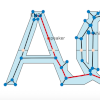Automated validation of route instructions in indoor environments
DOI:
https://doi.org/10.5311/JOSIS.2025.30.385Keywords:
route instructions, validation, floorplan complexity, grammar, instruction-following agents, text-based gamesAbstract
Indoor wayfinders often rely on verbal route directions, particularly in situations where other navigational aids may be unavailable or less effective. Ensuring the clarity and validity of these instructions is particularly important for navigation in complex indoor environments, such as airports and malls. However, current methods lack a reliable, systematic approach to computationally ensuring the a-priori validity of route instructions, failing to provide certainty to agents that they will be able to follow instructions successfully. Here we show a novel computational model for validating indoor route instructions, applicable to a wide range of indoor environments and turn-based grammars. Using a synthetic dataset of indoor floorplans with varying complexities, we demonstrate the model's capability to validate route instructions systematically. We systematize the requirements for route instruction validation in the framework which assesses instructions based on understandability, executability, path-following, and destination guidance. Our findings highlight the effectiveness of nuanced grammars, such as 8-sector grammar, for complex layouts and confirm the applicability of simpler grammars, like 4-sector grammar, for right-angle constrained environments. Importantly, we identify a transition point where the benefits of increased grammatical complexity on the descriptions of the turns are no longer productively supporting a reduction in turn ambiguity in the environments. This research shifts the field from subjective, time-consuming human evaluations to a computational approach, enhancing the reliability of indoor navigation systems.

Downloads
Published
Issue
Section
License
Copyright (c) 2025 Reza Arabsheibani, Stephan Winter, Martin Tomko

This work is licensed under a Creative Commons Attribution 3.0 Unported License.
Articles in JOSIS are licensed under a Creative Commons Attribution 3.0 License.
